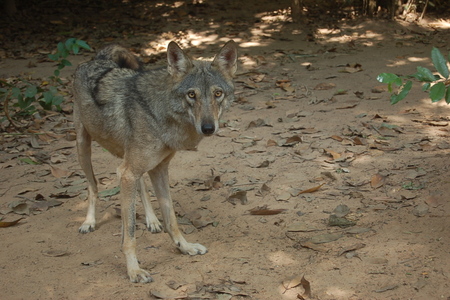West Bengal, April 30, 2014: In the Bishtupur village of the Bardhaman District of West Bengal, everyone knows the story of Dulal, a taxi driver and his adopted ‘son’ – a wolf called Bittu. When Dulal found Bittu, a young pup practically starving to death, alone in the jungle little did he know that the pup would grow up to be one of the most loyal and loving creatures he had ever met. But a wild animal is a wild animal at the end of the day and the constant attacks on the neighbours livestock and poultry left Dulal with little option but to rehabilitate him back to the wild, a decision he does not regret. 18 months after releasing him Dulal found Bittu thriving where he belonged, in the jungle.

Stories like these are rare not just because such a relationship between a wild animal and a human being is touted as ‘unnatural’ and ‘controversial’ but also because more often than not the burgeoning population of countries like India has left the wildlife and humans in constant conflict for space and resources. The wolves of West Bengal have been no exception and in a Rapid Action Project (RAP) by Wildlife Trust of India (WTI) in collaboration with Dr Urmilla Ganguli, with the aid of the David Shepherd Wildlife Foundation (DSWF), the first leg revealed a disturbing and somewhat paradoxical state of affairs. Along with a steep population decline of the Indian wolf the cases of conflict were also on a rise and so were the retaliatory killings.
Deeper investigations, which included status surveys, conflict surveys and distribution surveys, exposed habitat degradation, with illegal felling of trees being the leading cause, resulting in loss of territory, prey and water for the wolves of the Birbhum, Bardhaman and Bankura districts of the West Bengal. This directly led to them setting up their den sites near the villages and preying on the loosely guarded livestock and poultry.
Amrit Menon, a Project Officer of WTI’s Wild Aid Division which undertakes Rapid Action Projects across the country, elaborated on the situation saying, “The biggest problem in these districts was that villagers weren’t aware that they could claim compensation if their livestock had been killed by a wolf. The Indian wolf is a protected species listed under Schedule 1 of the Wildlife Protection Act, 1972. This technically gives safeguards the species listed and also entitles these villagers to monetary compensation if they suffer a loss as a direct result of a Schedule 1 animal. While the villagers don’t think that these wolves are natural adversaries, when they suffer an economic loss from their already meager incomes, that automatically creates animosity against the wild animals and that’s when retaliatory killings take place.”
Creating awareness among the villagers and helping them eventually get involved in wolf conservation became the primary priority of the RAP. Wolves, despite being the only large carnivore in the area, were not studied or even documented before this particular project- making it a first in the state. Wolf numbers had also gone down to the extent that rarely would anyone even see the species, making it difficult for the Forest Department to also validate any allegation of a wolf predation.
Dr Urmilla Ganguli commented on the awareness drives saying, “When we started talking to villagers they realised for the first time that the Forest Department can be approached in case of a loss. This has led to quite a dramatic shift in the attitude of the locals who now view the wolves with less angst than before. The Forest Department has also been quite supportive and helpful, taking active part in the awareness workshops which have been held in some 72 villages of these three districts. During Wildlife Week last year they took the initiative of holding meetings with the villagers and making them aware of the rights given by the government to the wolf as a protected species and the punishments which can be meted if a wolf is harmed. The local authorities are also helpful now with enforcement in cases of wolf killing, hunting or poaching. For instance in one case we managed to retrieve a dried skin of a wolf after he had been killed in a revenge hunt, his meat consumed and skinned for the fur. The perpetrators were arrested.”
The villagers were also educated about the importance of wolves in the ecosystem and the need for habitat restoration. “The response was phenomenal. The same villagers who would earlier kill the wolves out of fear of a future attack on their goats, now have started planting trees with slogans resounding ‘Save trees.. save forests… save wolves’. They’ve also proved to be invaluable resources when it comes to locating den sites and in a complete turnaround, they’ve come forward and volunteered to protect the sites! They’re very adamant about not letting the wolves go the tiger way and want this species, who has been sharing their landscape for thousands of years, to remain there for the rest of ages.”
“It’s quite heartening to see the youth of these districts come forward and recognize the importance of wildlife conservation. Human-animal conflict is on a drastic rise all over the country, with the jungles also under immense anthropogenic pressures, and we need more people like Dr Ganguli and her team to reach out to the locals who are otherwise not aware of their rights as well as of wildlife’s, if we need to mitigate conflict and secure a safer future for our natural heritage,” stated Amrit Menon.